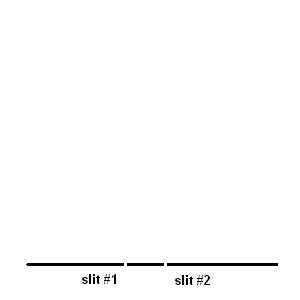 animation
animation
Answers to discussion topic questions in Unit 6
Please make sure you understand the answers before you attempt the practice quiz or unit test. Many of these answers came from your fellow students.
Tough Laser questions (which will not be on the test so please just skim over)
 animation animation
|
2. If someone gets the first question correct, someone else should try
explaining why a diffraction grating is capable of breaking white light into the
full spectrum. (also NOT on the test)
A diffraction grating is nothing more than many slits
imprinted on a slide. It is used to break white light into its component
parts (rainbow) just as you might expect in a prism. If you understand the
famous "double slit" experiment, you may be able to see why a diffraction
grating works. The wavelength of each color in the visible spectrum
is different. Blue has a shorter wavelength than red light.
Therefore, you would not expect constructive interference at the same spot on
the screen for all colors. You would expect blue light waves to be "in
phase" a bit closer to the center.
 animation
animation
If you were able to digest all this, you may have a clue how holograms work.
The hologram itself is nothing more than a very complex pattern of a light and
dark images on a plate which act like a diffraction grating. To get bright
spots to appear off to the side, you need to rely on constructive interference.
Now I'll toss in one last twist and you may start seeing the light (pardon the
pun). You can also control where (on the screen) the bright spots appear
by altering the distance between slits. The closer the slits are, the more
"spread out" the interference pattern becomes.
This applet lets you see this in a virtual environment.
Application of Lasers - The great part of this class is your instructor can learn from the student. Below are some posts I've never heard about until you told us.
New televisions will incorporate lasers. These TVs also known as LPD TV have a glass matrix display that have red, green and blue phosphor that glow when a laser is used. So you can add this technology against LCD and Plasma TV when shopping for a new TV (probably not in the near future). Source Note: It looks like a laser replaces the electron beam in older CRT (cathode ray) TVs.
Sound
 animation
animation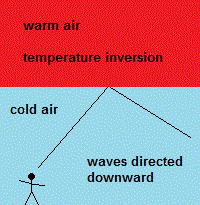
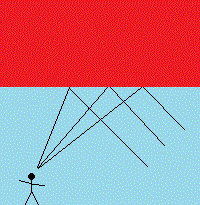
 animation
animationGPS applications
Most all posts deal with the ability of a GPS to pinpoint the location of an person or thing. This can include kids, pets, prisoners, cars, and many, many more items. One student pointed out that the GPS is used extensively in marketing. Companies can target where to apply resources (such as advertising) based on where you are. The student used this example: If you spend most of your time at home, advertisers will keep this in mind and attempt to sell you products for home use or services to deliver items to your house. A GPS can also determine the speed and acceleration of an object (so you not only can track your kids location, but find out if they are speeding). But here is one thing most students miss ... time. Once calibrated, a GPS has atomic clock accuracy (without the atomic clock price tag). This ability of a GPS has many applications such as precise time stamps for financial transactions and synchronization of communications systems (such as power plants). More on this here.
Wave Modulation
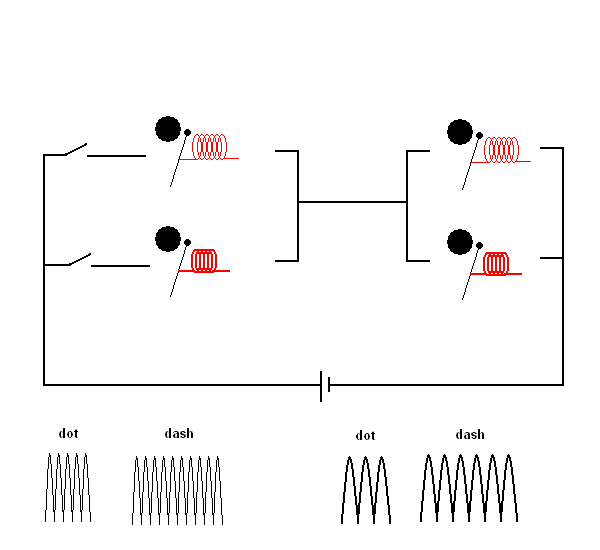
Waves as Probes
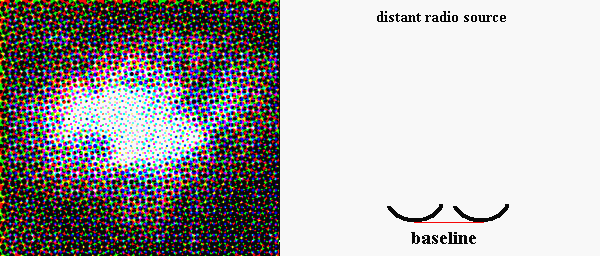 animation
animation
Reflected waves
This is not earth shattering but some newer cars are equipped with rain sensors to automatically activate the windshield wipers. It works because a device mounted in your rearview mirror sends IR radiation towards the front windshield at a slight angle. If raindrops are not present, you can expect a certain amount of reflection back to the mounted device. However, the amount of radiation returned to the sensor changes if drops of water are present on the glass.
Where I work we test if cables are good by using a TDR (Time-Domain reflectometer). Basically it sends a pulse down a coax cable. If the cable is good, it passes to the end unobstructed. If the cable is bad, the pulse is reflected back and this tells us there might be a twist or bend in the cable.
In the industrial world a type of ultrasound known as ultrasonic testing, is often used as a way to check for internal flaws in materials such as steel or defects and leaks in pipes. Because you cannot see inside of piece of steel this is very handy to know if there would perhaps be a bubble or other weak point within the material. It can also be applied to materials such as concrete.
Great discoveries made by observing an unexpected type of wave (or a wave from an unexpected source).
The idea that the entire universe came from a singe event known as the Big Bang came from the accidental discovery that there are faint microwaves coming at us from all directions. This is known as the cosmic background radiation discovered by Arno Penzias and Robert Wilson in 1964.
Pulses of X-rays from Cygnus X-1 (a star in the constellation Cygnus) led
astronomers to believe that it has a black hole as a binary
companion. You cannot see a black hole but its existence is inferred by
the behavior of the visible star. It is believed X rays are produced as
the black hole pulls material off the companion which superheats as it funnels
to the event horizon.
Einstein put another feather in his hat when gravitational waves were discovered
in 2015. These are waves that represent ripples in the fabric of space
(and time) which were likely produced when two black holes merged. These
waves were not unexpected ... but never detected despite years of observing by
the LIGO observatory. The discovery provided one more piece of
evidence that Einstein was correct.
Great discoveries made by using a beam of particles
About a century ago Ernest Rutherford sent high speed alpha particles (helium nuclei) at a gold foil target. He noticed that most went straight through but on rare occasions, some were deflected (even sent back to the source). He concluded that a majority of the atom was empty space and that most of the mass was concentrated in a very small volume which we call the nucleus.
One common medical scan is known as a PET Scan. This stands for Positron Emission Tomography. The key to this technique relies on the fact that cancer cells take in glucose at a higher rate than normal tissue. Therefore, a radioactive isotope (with a very short half-life) is attached to the glucose. When injected into the body, this isotope concentrates in cancer tumors. During the decay of the radioactive isotope, a positron is emitted which interacts with a nearby electron ... producing gamma rays (as a pair moving in opposite directions). All you need to do is make an image from these gamma ray emissions to discover the location of the tumor. A similar technique (called SPECT) is used in nuclear medicine to map your cardiovascular system or to perform a bone scan.
If a fire breaks out in your house, a beam of particles may decide if you survive. If your fire alarm is the "ionization type", it consists of a small amount of Americium 241 ... a radioactive substance that emits alpha particles (the same thing that makes up the nucleus of a helium atom). These particles have the ability to ionize oxygen and nitrogen (the stuff that makes up air). Now place two plates close to the Americium 241 and give each plate opposite electric charges (with a battery). Under normal conditions (no fire), the ionized particles will be attracted to the appropriate plate which constitutes an electric current. However, if there is a fire, the smoke particles are able to neutralize the ions and no current results. This is sensed and triggers the alarm to go off.
Physicists are trying to understand what the universe was like just after the "Big Bang". In that effort, they have constructed a particle smasher known as the LHC (Large Hadron Collider) in Europe. By accelerating and colliding protons and lead ions at nearly the speed of light, they are hoping to find a particle known as the Higgs boson. Why? Discovering the existence of this particle will confirm theories cosmologists use to understand the nature of matter and how our universe evolved. Good news .... in 2012 the Higgs boson has been found..
Great discovery made by studying an absorption spectrum
All stars emit an absorption spectra. The lines not only tell the chemical composition of the star, it can also tell the temperature of the star as well. Early astronomers thought that strong absorption lines from a specific element meant that the star had a lot of that element in its chemical makeup. Wrong! It turns out, the strength of the lines (how well defined they are) depends on the temperature at the surface (photosphere). All stars are mostly hydrogen and helium, and only a handful of the rest of the elements. Stars are classified by temperature on a scale OBAFGKM - O being the hottest and M being the coolest. This is obtained by noting which element's absorption lines are the strongest and most well defined.
Give one application where the Doppler Effect is used to obtain the speed of an object or investigate how something is moving.
Since all stars have absorption lines, they make a great reference mark to measure their speed (via the Doppler effect). That is, the lines are blue shifted if it is approaching and red shifted if receding from us. For example, if two stars are binary companions and their orbital plane is in our line of sight, one star will be approaching us at the same time the companion is moving away from us. By measuring the Doppler speed, one can establish how the mass is distributed in the system by comparing speeds. If both stars have equal mass, the speeds will be equal. However, if one star is very massive and the companion has a low mass, the Doppler shifts will show that the high mass star moves slow and the low mass star will move with a much higher speed. If interested, see http://ecampus.matc.edu/mihalj/astronomy/test3/doppler.htm (the applet says it all).
The Doppler effect is used to monitor heart movement. This process is known as echocardiography. This is a process of using sound waves to create an image of the heart.
A Laser Doppler vibrometer (LDV) is used to take measurements of a surface through vibrations, without coming in direct contact with the surface. This makes it beneficial for use in areas where contact is not possible because the surface may be too difficult to reach or when it is not possible to come in contact with the surface in general, such as when it is used in the detection of land mines. LDV's are also used in the architectural industry for bridge and structure vibration tests, in the automotive industry for structural dynamics and brake diagnostics, and in the medical field for eardrum diagnostics.
Give any example (not already mentioned) where a wave passes by an object and is effected (in any observable way) as a result. Has any great discovery ever been made using this idea?
One type of smoke detector is a photoelectric type. The animation below shows that if no smoke is present, the light never hits the photo sensor. However, if smoke is present, some of the light is scattered in the direction of the photo sensor and an alarm sets off.
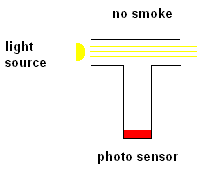
animation of a photoelectric smoke detector
One phenomena is known as a
gravitational lens. Einstein showed that light is refracted by a
gravitational field in the same way light is refracted by a lens. If
something were in deep space and had a lot of mass, it would be possible for
light rays to focus its radiation to the earth (of course, the geometry has to
be right). Guess what? Astronomers have seen this effect several
times and are convinced that the universe has MUCH more mass in it than shows up
in our detectors. This mass is called "dark matter" and could make up most of the
universe.
Want more astronomy news? Einstein predicted something called "gravitational waves" would result from the merger of very massive objects (like black holes or neutron stars). In October 2017, gravity waves were detected from the merger of two neutron stars. Some really clever astronomers determined that it is possible to determine the distance to the event by measuring the strength of the incoming wave at the detector. In theory, the merger of neutron stars should produce a wave in gravity with a known amplitude. As that wave spreads out, the amplitude decreases at a known rate, allowing you to predict how far away the event occurred. As an analogy, if you toss a rock in water, the waves spread out and the amplitude of the wave decreases with distance. If you know how big the wave was to start with, you can predict the amplitude of the wave at any distance.
Airport Security
The next time you visit the airport, you could walk by a "hands free" security check point. There are two types of scanners used for airport security - the Backscatter scanner (which is nothing more than a low level X-ray scanner) and the Millimeter Wave scanner. In this technology, two rotating antennas emit radio waves that are directed toward your body and reflect off your skin. The reflected waves are collected to produce a 3-D image. Any metals, plastics, or liquids between your skin and the receivers show up on the image. Busted! This same machine can be used in the fashion industry. Imagine getting "fitted" in a virtual dressing room. This has already been used in some Fashion Bug stores under the name - Intellifit.
Rogue waves! These types of waves are known as killer (ocean) waves because they can sink a ship in seconds. Back in 1995, this wave appeared on a scientific instrument which recorded this wave up to 80 feet high making it three times as high as a normal wave. Rogue waves are many waves united together to cause complete destruction in the sea. Note: Ironically, the destruction of a ship is caused by constructive interference of random ocean waves.
CyberKnife is a relatively new way to destroy cancerous tumors. Basically it is a device that is able to emit cancer killing X-rays that enter the body from many different directions which intersect and concentrate their energy at the site of the tumor ... destroying it. No scalpels, no pain, and very few side effects. I know, I went through this procedure to (hopefully) cure prostate cancer. An even newer approach is to do the same with a beam of protons (instead of X-rays).
Biotechnology is a subset of nanotechnology in that it uses living
tissue (cells) to make something useful. One could argue that biotechnology has
been around for a long time since biologists have long been altering genes to
grow hybrid crops that grow in new or stressed environments, become resistant to
disease, produce higher yields, or simply taste better. However, let’s go
beyond agricultural applications and discover some insanely interesting ways
biotechnology has (or will) make our lives better.
As a model, let me introduce one application that uses biotechnology to make a
game changer in the field of fuels.
Several private companies are in a race to find a way to use simple grass (and
other waste biomass products) in a process to make a combustible fuel. Rather
than using the tradition method of fermentation to make ethanol, the twist is to
genetically engineer e-coli or algae to digest the biomass and “poop” out fuel.
The “cellulosic ethanol” not only emits less carbon dioxide but uses biomass
that is not in direct competition with the food industry.
Now it is your
turn. Find something specific and interesting in the field of biotechnology and
post away.
Note: This is a new question so I will post future applicable posts
The electrical conducting properties of
graphene can be altered by the presence (or lack of) an external electric
field. As a result, graphene could used to make extremely small and
efficient transistors. This could be big news for the computer industry some
day.
Gas molecules that land on the surface of graphene can alter its electrical
conductivity by changing the overall resistance (which can be monitored). As
a result, graphene can be used as a gas sensor.
Graphene is resistant to attack from strong acids and bases. As a result, a
sheet of graphene could act as a protective layer from these corrosive agents.
Because graphene is essentially transparent and can conduct electricity, it
may be used in many optical applications such as touch screens and liquid
crystal displays.
Graphene has excellent heat conduction properties. As a result it can be
used as a "heat sink" to draw heat away from hot spots in electronic devices.
There are likely
many more potential applications for graphene. This is just
a short list.
What is carbyne, what are some its physical properties, and how can it be put into practical use?
Unlike graphene which is a sheet of carbon atoms, carbyne is a string of carbon atoms that forms very strong bonds with adjacent atoms (like links in a chain). In addition, one string of carbyne will form “cross-link” bonds with adjacent strings of carbyne. This makes carbine stronger than graphene or diamond. Since this material is fairly new, the practical applications are still a mystery but some scientists have suggested that stings of carbyne could act as energy storage medium (resulting from the “cross-link” bonds formed between adjacent stings).
The equation E=Mc2 was shown
(in the eBook) that mass can be converted into energy. Has there been any
instance where the reverse occurred? That is, where energy has been
converted to mass?
Technically ... no ... not in the lab at least.
There is a counterpart to all particles we call antimatter.. A positron is
a positively charged electron. There are antiprotons, antineutrons, etc.
When a particle of matter interacts with its antiparticle counterpart, they
annihilate each other and produce pure energy in the form of electromagnetic
radiation (high energy photons). The opposite of this reaction has been
predicted, in theory, where two (gamma range) photons collide and create an
electron and positron. The problem is, most particle accelerators (like
the Large Hadron Collider) only smash particles together .. not
radiation. Some
scientists believe this can be done with existing technology but that has
still not been done experimentally.
Just because we have not done this experimentally (yet), the theory is so well
established that there is little doubt that this process is possible.
Astronomers believe the universe started with a Big Bang ... of energy.
The conditions were so extreme that these photons would collide, producing all
the matter we now see in the universe. The problem is ... where is all the
antimatter? That problem is still unanswered but may be explained
if unstable antimatter decays at a different rate than ordinary matter.
Briefly explain what went wrong at the
Chernobyl nuclear power plant in 1986.
Chernobyl was a disaster in design, procedure, and human
error. Technicians realized there was a design flaw in the power plant.
They wondered if emergency power could be supplied to the cooling pumps by the
inertia of the spinning turbines because backup power didn't kick in fast
enough. In an attempt to test this scenario, several safety procedures
were deliberately bypassed. Bad idea ... since the people doing the test
were electricians .. not nuclear engineers. The result was no water being
pumped into the reactor to cool it and no control rod deployment to shout it
down. By the time the "kill switch" was hit, it was too late. An
overheated core produced a feedback loop that accelerated the nuclear reactions.
A steam explosion blew the top off the reactor .. and the plant was not designed
with a containment vessel. Chernobyl is a ghost town now. The good
news is this could not happen in any US nuclear power plant by engineering
design and a completely different set of safety regulations.
Briefly explain what went wrong at the
Fukushima nuclear power plant in 2011.
An earthquake struck off the coast of Japan on March 11,
2011. This was followed by a massive tsunami. Although the Fukushima
plant had imitated shutdown procedures, multiple power backup systems all
failed. This power was needed to run pumps to keep the core cool (even if
control rods were in place).
In the last few decades, the US
decreased its reliance on nuclear power to generate electricity. Can
the opposite be said about any other nations? Explain.
Events at Three Mile Island, Chernobyl, and Fukushima have
triggered a global reduction of the use of nuclear power. Look at
this graph to see that following nuclear disasters, the world took notice
and greatly reduced their reliance on nuclear power. The noticeable
exception is China which has 27 new reactors under construction. There are also
new reactors being built in South Korea, India, and Russia
What is the US currently doing with the
radioactive wastes produced by nuclear power plants?
The answer is ... virtually nothing! In 2011, the US
had over 72,000 tons of high-level nuclear waste with no long-term facility for
storing it. Right now, these waste products are mainly kept "on site" in
temporary storage. Most of the contamination at Fukushima came from
leakage of spent fuel! Long range plans are to bury it deep in a
geologically inactive and stable place. So where is that? .... and
who would want that in their back yard? ... and how do you insure that it won't
contaminate your ground water?
We should note that nuclear wastes encompasses a wide range of fission
byproducts ... each with its own half life. Waste products with short half
lives will safely decay quickly. It is the materials with long half lives
that pose a big problem and are labeled High Level Wastes (HLW) ... these have
half lives that measure in the millions of years range. Yikes!!!
What is a Liquid Fluoride Thorium
Reactor? Are there any of these rectors currently in operation? What are the advantages
of this type of nuclear reactor?
The details of this type of reactor were worked out in the
1960's but never implemented. Basically, thorium is used to make uranium
233 which then becomes the fuel in the reactor. Since it is liquid, the
fuel itself is circulated and heat is transferred to a closed loop where steam
drives a turbine. This reactor has several advantages over all traditional
nuclear reactors. Thorium is abundant and all the waste products of this
reactor have extremely short half lives when compared to currently used power
plants. A core failure is virtually impossible (even if external power is
cut off) since an overheated core will just melt a plug and the contents would
drain into specially designed vessels. There is no need to use extremely
high pressures, eliminating dangerous steam explosions. The only downside
is this reactor needs to be kick started with traditional technologies.
Why isn't this put into effect? Several nations are investigating this but
public opinion on anything nuclear is currently a major deterrent.
How many nations currently have
thermonuclear weapons? Which nation(s) or organizations do you feel pose
the greatest threat to world peace with these devices?
There are currently
nine nations with nuclear weapons. IMHO, the biggest threat comes not
from any single nation (since releasing those weapons is akin to suicide), but
from isolated
radical groups who could manage to get their hands on some. The bombs
need not be detonated, but used as ransom and/or to sabotage water systems
(maybe I've just watched too many James Bond movies).
Are there currently any fusion reactors?
What are some of the major obstacles in the quest for energy from fusion
reactors. What is break-even? Has it been achieved?
Commercial fusion plants are decades away, but several
reactors are in the research and testing phase. The problem is how do you
confine hydrogen, get it to a superheated state, and stay that way after it
fuses. There are several approaches .. mostly using lasers or magnetic
forces. It is not easy containing a tiny hydrogen bomb. It takes a
lot of energy to run all these devices so the first goal is to achieve
break-even. That occurs when the energy you get OUT of the fusion reactor
is equal to the energy you put IN. Scientists are
very close to this major
goal. I may have to change this answer any day.
Astronomers tell us the universe only
consisted of hydrogen, helium, and lithium after the Big Bang. How do they
account for the origin of all the other elements we see on the periodic table?
Theory predicts that you can fuse any element up to iron
and release energy. The only problem is it takes higher temperatures and
pressures each step you take (as you move toward iron). The only place
nature currently produces these conditions is in the cores of very massive stars
(much more massive than our sun). Our sun is converting hydrogen to helium
but it doesn't have enough mass to do much more than that (except when it dies
and flashes helium to carbon). Massive stars can synthesize all the
elements up to iron BEFORE they die ... and when they die ... it is a
spectacular event known as a supernova. When these stars blow up, there is
so much energy available that some of it is used to fuse all the elements beyond
iron on the periodic table (even though these reactions absorb energy). We
know this because we can study the spectra of supernova remnants and identify
these elements as they spew out into space. The real cool thing is this
provides building blocks to make new star systems and worlds .. like Earth.
What are the dangers of a buildup of
radon gas in your basement? How does it get there and how can the problem
be eliminated?
The
EPA predicts that up to
20,000 lung cancer deaths are the result of radon gas. There are two
isotopes of this gas - radon-222, and radon-220 ... both radioactive.
Radon 222 is the byproduct in the decay of Urnaium 238 and Radon 220 is the
byproduct in the decay of thorium-232. Both uranium and
thorium are elements found in nature so there is no way possible to avoid them.
Because radon is a heavy inert gas, it is able to migrate from its place of
origin and may settle in basements and wells. Radon emits alpha particles
(the nucleus of helium atoms) which are dangerous to humans and animals if
exposed to in high amounts.
The first step is to see if your basement hold unacceptable levels of radon gas.
Home tests can be purchased at any home supply store for about $10. If you
test positive for high radon levels, it will cost about $1,000 to have a
ventilation system installed in your home.
Give one specific application where the radioactive properties of a material are put to use.
We are still receiving data from the Voyager probes which are well over 100 times further from the sun than the earth is. Voyager 1 & Voyager 2 were launched in 1977. The cameras are turned off but it still has enough power to transmit until the mid 2020's. At launch, both probes produced 470 w of 30 volt DC electrical power. To put this in layman's terms, this is the power output of a light bulb. However, since the power comes from the heat produced by the radioactive decay of Plutonium (that is attached to one junction of a thermocouple), the power levels have slowly dropped over time. This mandates that systems must be turned off, one-by-one, as the power levels drop.
This one could be big some day. How about a AAA battery that runs off the decay of radioactive nickel - 63? The prototype has 10 times the power of a standard chemical battery and would last much longer (the half life of nickel 63 is 100 years). Click here to read more.